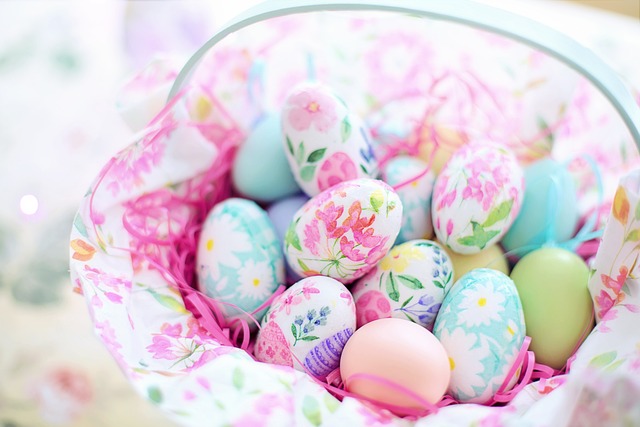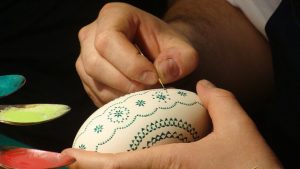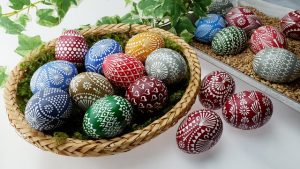 KV asks: “Is coloring/decorating eggs for Easter a pagan tradition?”
KV asks: “Is coloring/decorating eggs for Easter a pagan tradition?”
There is some evidence that pagans decorated eggs to celebrate their festivals because many cultures regarded the egg as a symbol of fertility and the rebirth of nature in spring; however, the practice of decorating eggs at Easter time has a long and cherished Christian history of its own.
Some of the confusion about the origins of the decorating of Easter eggs has to do with the claim that the name of Easter was derived from a pagan goddess, Eostre, also known as Ishtar. Eostre was celebrated with Anglo-Saxon festivals in the spring during which time eggs were buried and then eaten. Hence, the claim by some that the name of Easter, and the practice of decorating eggs, actually originated with this goddess.
However, when the facts are considered, this association becomes quite a stretch.
First, there is almost no historical record of Eostre other than a few sentences written by St. Bede: “Eosturmonath has a name which is now translated ‘Paschal month’, and which was once called after a goddess of theirs named Eostre, in whose honor feasts were celebrated in that month. Now they designate that Paschal season by her name, calling the joys of the new rite by the time-honored name of the old observance” (The Reckoning of Time, 725 AD).
As Jon Sorenson of Catholic Answers points out, the fact that the worship of this goddess was largely localized raises the question, “Why would the Catholic Church bother to create a holiday simply to supplant the celebration of one or two backwoods tribes?”
 As for the name “Easter” being derived from Eostre, regardless of the seeming similarities in the names, “the Christian celebration of the resurrection of Jesus is called ‘Easter’ only by English-speaking Christians,” Sorenson points out. “The rest of the world calls it Pascha—or some derivative of that—which means ‘Passover’ to commemorate the sacrifice of Our Lord, our ‘pascal lamb.’”
As for the name “Easter” being derived from Eostre, regardless of the seeming similarities in the names, “the Christian celebration of the resurrection of Jesus is called ‘Easter’ only by English-speaking Christians,” Sorenson points out. “The rest of the world calls it Pascha—or some derivative of that—which means ‘Passover’ to commemorate the sacrifice of Our Lord, our ‘pascal lamb.’”
Regardless of the origin of the name of Easter, the Christian custom of decorating eggs has a long and well-documented history.
As Father John Flader describes in this article, “The egg can be seen as a symbol of the sealed tomb from which Christ emerged after his resurrection, just as the chick emerges from the closed egg. From ancient times it was also seen as a symbol of new life. And since eggs were one of the foods from which people fasted in Lent in the early Church as they still do in the Orthodox tradition, people looked forward to eating them again and associated different customs with them.”
From as early as the fourth century in the East, eggs were blessed at Easter time. Known as the Benedictio Ovorum, the blessing of eggs, came to the West in the twelfth century, possibly brought there by the Crusaders.
“Red eggs, sometimes emblazoned with a cross, are still the custom in the Orthodox and Eastern Catholic traditions. They are blessed by the priest at the end of the Easter Vigil and distributed to the faithful.”
During medieval times it was a custom to give eggs at Easter to the household servants. King Edward I of England is said to have distributed 450 eggs that were boiled and then covered in gold leaf to every member of the royal household on Easter.
We’re all familiar with the fabulous Faberge eggs that were decorated for members of the Russian Imperial Court.
 Christians in Northern Europe have been painting eggs in bright colors at Easter for centuries with the first edition of the Roman Ritual, dated 1610, containing a special blessing for the eggs.
Christians in Northern Europe have been painting eggs in bright colors at Easter for centuries with the first edition of the Roman Ritual, dated 1610, containing a special blessing for the eggs.
Countries such as Poland, Lithuania, Ukraine and the Czech Republic have made egg decorating into a work of art by producing magnificently decorated eggs as gifts for relatives and friends.
“In Germany thousands of brightly colored emptied-out eggs are hung on the barren branches of outdoor trees known as Easter egg trees to give a very festive appearance. They are also hung on tree branches in flower pots and used as table decorations,” Father writes.
“In some traditions Easter eggs are even offered to the deceased. After a memorial service the people go on the second Monday or Tuesday after Easter to take blessed eggs to the cemetery where they say the traditional Easter greeting ‘Christ is risen’ in honor of those buried there.”
The painting of eggs at Easter is a beloved Christian tradition that can only be made even more special by returning to the original symbols of Easter that have been painted on these eggs for nearly 2000 years.
In this article appearing on Catholic Culture, Jennifer Gregory Miller suggests, “To bring back the eggs to the original symbolism decorate the eggs with liturgical symbols or spiritual themes. This can used as an artistic challenge for all those budding artists in the family. There are numerous ways to decorate eggs, but one easy way is to take Crayola Crayons® (this brand works best) on a plain boiled egg. Color the egg with different designs and symbols, and then the eggs are dyed in food coloring, available at any food store. Using Crayon colors like white, yellow and other light colors to create designs on the eggs result in an interesting contrast against the darker colors of the dyes.”
Some suggested symbols:
Symbols of the Resurrection: Easter lily, butterfly, peacock, bursting pomegranate, the phoenix, the sparrow, the bee, the egg, Jonah and the fish;
Easter scenes: an empty tomb, an empty cross with a white cloth hanging, lamb with banner, Christ in white garments, angels at the tomb;
Other religious symbols: crosses, doves, lambs, triangle (for the Trinity), grapes, chalice, fish, Chi-Rho, Alpha and Omega;
Joyful phrases: “Alleluia, He is Risen!” “Christ is Risen, Alleluia!”, “Christus Resurrexit Alleluia!” “The Lord is Risen!”, “This is the day the Lord has made, alleluia!”; “Christ has become our paschal sacrifice.”
The practice of decorating eggs at Easter is a Christian tradition that symbolizes the hope of the resurrection and a joyful end to the long season of Lent.
© All Rights Reserved, Living His Life Abundantly®/Women of Grace® http://www.womenofgrace.com









